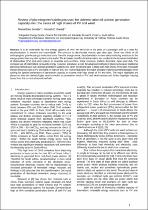 ResearchSpace
ResearchSpace
A review of planning methodologies used for determination of optimal generation capacity mix: the cases of high shares of PV and wind
JavaScript is disabled for your browser. Some features of this site may not work without it.
- ResearchSpace
- →
- Research Publications/Outputs
- →
- Journal Articles
- →
- View Item
| dc.contributor.author |
Senatla, Mamahloko J

|
|
| dc.contributor.author |
Bansal, RC

|
|
| dc.date.accessioned | 2019-05-31T07:50:39Z | |
| dc.date.available | 2019-05-31T07:50:39Z | |
| dc.date.issued | 2018-08 | |
| dc.identifier.citation | Senatla, M.J. and Bansal, R.C. 2018. A review of planning methodologies used for determination of optimal generation capacity mix: the cases of high shares of PV and wind. IET Renewable Power Generation, Vol 12(11), pp. 1222-1233 | en_US |
| dc.identifier.issn | 1752-1424 | |
| dc.identifier.issn | 1752-1416 | |
| dc.identifier.uri | http://digital-library.theiet.org/content/journals/10.1049/iet-rpg.2017.0380 | |
| dc.identifier.uri | DOI: 10.1049/iet-rpg.2017.0380 | |
| dc.identifier.uri | https://digital-library.theiet.org/content/journals/10.1049/iet-rpg.2017.0380;jsessionid=bn1808j4h36j0.x-iet-live-01 | |
| dc.identifier.uri | http://hdl.handle.net/10204/10995 | |
| dc.description | Copyright: 2018 The Institution of Engineering and Technology (IET). Due to copyright restrictions, the attached PDF file only contains the abstract version of the full-text item. For access to the full-text item, please consult the publisher's website. The definitive version of the work is published in IET Renewable Power Generation, Vol 12(11), pp. 1222-1233 | en_US |
| dc.description.abstract | It is undeniable fact that energy systems all over the world are at the point of paradigm shift as a need for decarbonisation is eminent and unavoidable. The pressure to decarbonise mounts year after year. Since two thirds (67%) of all anthropogenic greenhouse-gas emissions (GHGs) come from the energy sector, decarbonisation is more about reducing emissions in the energy system than any other system in the world. Research has shown that wind and photovoltaic (PV) technologies have dominated the markets with some countries having a combined penetration shares as high as 40%. The increased use of intermittent renewable energy resources introduces a need for advanced methods of planning because traditional planning methods give sub-optimal generation capacity mix when the electric grid is faced with high shares of variable renewable energy resources such as PV and wind. In light of this, this review highlights the major changes in planning methodologies when solving for optimal penetration of generation capacity in systems with high shares of PV and wind. The major highlights are placed on why the methodologies need to evolve as penetration levels of PV and wind increase and further highlight what it still missing on the current advanced methods. | en_US |
| dc.language.iso | en | en_US |
| dc.publisher | The Institution of Engineering and Technology (IET) | en_US |
| dc.relation.ispartofseries | Workflow;19942 | |
| dc.subject | Optimal capacity mix | en_US |
| dc.subject | Photovoltaic | en_US |
| dc.subject | PV | en_US |
| dc.subject | Wind | en_US |
| dc.subject | Planning methodology | en_US |
| dc.title | A review of planning methodologies used for determination of optimal generation capacity mix: the cases of high shares of PV and wind | en_US |
| dc.type | Article | en_US |
| dc.identifier.apacitation | Senatla, M. J., & Bansal, R. (2018). A review of planning methodologies used for determination of optimal generation capacity mix: the cases of high shares of PV and wind. http://hdl.handle.net/10204/10995 | en_ZA |
| dc.identifier.chicagocitation | Senatla, Mamahloko J, and RC Bansal "A review of planning methodologies used for determination of optimal generation capacity mix: the cases of high shares of PV and wind." (2018) http://hdl.handle.net/10204/10995 | en_ZA |
| dc.identifier.vancouvercitation | Senatla MJ, Bansal R. A review of planning methodologies used for determination of optimal generation capacity mix: the cases of high shares of PV and wind. 2018; http://hdl.handle.net/10204/10995. | en_ZA |
| dc.identifier.ris | TY - Article AU - Senatla, Mamahloko J AU - Bansal, RC AB - It is undeniable fact that energy systems all over the world are at the point of paradigm shift as a need for decarbonisation is eminent and unavoidable. The pressure to decarbonise mounts year after year. Since two thirds (67%) of all anthropogenic greenhouse-gas emissions (GHGs) come from the energy sector, decarbonisation is more about reducing emissions in the energy system than any other system in the world. Research has shown that wind and photovoltaic (PV) technologies have dominated the markets with some countries having a combined penetration shares as high as 40%. The increased use of intermittent renewable energy resources introduces a need for advanced methods of planning because traditional planning methods give sub-optimal generation capacity mix when the electric grid is faced with high shares of variable renewable energy resources such as PV and wind. In light of this, this review highlights the major changes in planning methodologies when solving for optimal penetration of generation capacity in systems with high shares of PV and wind. The major highlights are placed on why the methodologies need to evolve as penetration levels of PV and wind increase and further highlight what it still missing on the current advanced methods. DA - 2018-08 DB - ResearchSpace DP - CSIR KW - Optimal capacity mix KW - Photovoltaic KW - PV KW - Wind KW - Planning methodology LK - https://researchspace.csir.co.za PY - 2018 SM - 1752-1424 SM - 1752-1416 T1 - A review of planning methodologies used for determination of optimal generation capacity mix: the cases of high shares of PV and wind TI - A review of planning methodologies used for determination of optimal generation capacity mix: the cases of high shares of PV and wind UR - http://hdl.handle.net/10204/10995 ER - | en_ZA |





